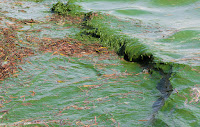 Earlier this month we saw the approval of a bill creating a reservoir system to the south of Lake Okeechobee to help mitigate toxic algae blooms resulting from nutrient runoff around the lake. This discharge typically makes its way down the Caloosahatchee and St. Lucie rivers and into the coastal waterways on both sides of Florida, polluting marinas and beaches with thick green muck. The environment and economy in South Florida are hit hard by this pollution
Earlier this month we saw the approval of a bill creating a reservoir system to the south of Lake Okeechobee to help mitigate toxic algae blooms resulting from nutrient runoff around the lake. This discharge typically makes its way down the Caloosahatchee and St. Lucie rivers and into the coastal waterways on both sides of Florida, polluting marinas and beaches with thick green muck. The environment and economy in South Florida are hit hard by this pollution
Sometimes referred to as “guacamole” algae, blue-green algae is composed of Cyanobacteria. These organisms feed on the nitrates and phosphates from fertilizers used on farms and in urban environments, and as the excess nutrients build up in waterways from faulty dikes or stormwater runoff, algae populations thrive, and their population increases dramatically. The growth and spread of algae will often block sunlight from the floor of a water body, causing aquatic plants to die off. The resulting dead organic matter becomes food for other bacteria that decompose the decaying plant life, and with a much larger food source, these bacteria begin to use up the dissolved oxygen in the water. Fish and aquatic insects are the first to die off when the dissolved oxygen is used up, then, manatees, dolphins, and larger marine life begin to lose their food source from habitat destruction.
Furthermore, blue-green algae produce a neurotoxin called “microcystin” which is harmful to humans, animals, and aquatic life. While this toxin primarily targets the liver, it is also a skin, eye, and throat irritant. For this reason, communities issue public health advisories during blue-green algae or cyanobacteria blooms to protect people and their pets.
GEI Works manufacturers floating containment boom that can effectively manage and section off large algae blooms, however, for projects like the Okeechobee Lake Reservoir Plan, it is necessary to include long-term management and mitigation of nutrient and stormwater runoff.
 Water quality impacts us all. Blue-green algae and cyanobacteria not only occur in Florida but throughout the US and around the world. GEI Works provides global water pollution prevention and containment solutions such as turbidity curtain, aquatic plant boom, erosion control products, stormwater BMPs, flocculants, water trailers, secondary containment, and more. For more information contact us at 772-646-0597 or visit GEIWorks.com.
Water quality impacts us all. Blue-green algae and cyanobacteria not only occur in Florida but throughout the US and around the world. GEI Works provides global water pollution prevention and containment solutions such as turbidity curtain, aquatic plant boom, erosion control products, stormwater BMPs, flocculants, water trailers, secondary containment, and more. For more information contact us at 772-646-0597 or visit GEIWorks.com.
Stay tuned next week as we continue our aquatic plant control blog series!


No comments:
Post a Comment